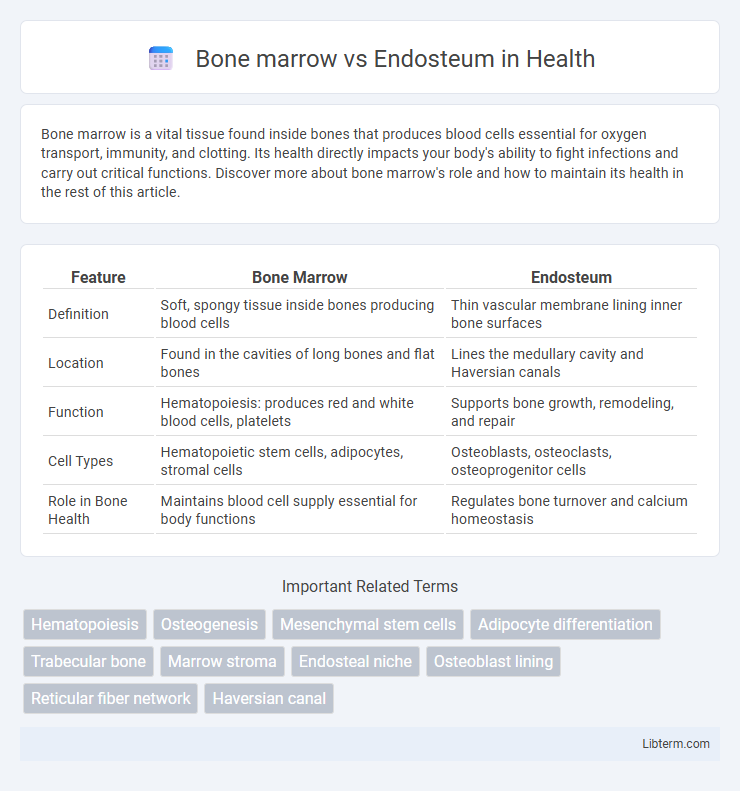Bone marrow is a vital tissue found inside bones that produces blood cells essential for oxygen transport, immunity, and clotting. Its health directly impacts your body's ability to fight infections and carry out critical functions. Discover more about bone marrow's role and how to maintain its health in the rest of this article.
Table of Comparison
| Feature | Bone Marrow | Endosteum |
|---|---|---|
| Definition | Soft, spongy tissue inside bones producing blood cells | Thin vascular membrane lining inner bone surfaces |
| Location | Found in the cavities of long bones and flat bones | Lines the medullary cavity and Haversian canals |
| Function | Hematopoiesis: produces red and white blood cells, platelets | Supports bone growth, remodeling, and repair |
| Cell Types | Hematopoietic stem cells, adipocytes, stromal cells | Osteoblasts, osteoclasts, osteoprogenitor cells |
| Role in Bone Health | Maintains blood cell supply essential for body functions | Regulates bone turnover and calcium homeostasis |
Introduction to Bone Marrow and Endosteum
Bone marrow is a soft, spongy tissue found within the medullary cavities of bones, responsible for hematopoiesis, producing red blood cells, white blood cells, and platelets. The endosteum is a thin vascular membrane lining the inner surface of the bone cortex, playing a crucial role in bone growth, repair, and remodeling by housing osteoblasts and osteoclasts. Both bone marrow and endosteum contribute to skeletal health but serve distinct physiological functions within the bone microenvironment.
Anatomy: Bone Marrow vs Endosteum
Bone marrow is a soft, spongy tissue found within the medullary cavities of long bones, responsible for hematopoiesis and fat storage. The endosteum is a thin, vascularized membrane lining the inner surface of the bone, including the medullary cavity and trabeculae, playing a critical role in bone growth, remodeling, and repair. While bone marrow provides the cellular environment for blood cell production, the endosteum contains osteoprogenitor cells essential for bone regeneration and maintenance.
Location within the Skeletal System
Bone marrow resides within the medullary cavities of long bones and the trabecular spaces of spongy bone, serving as the primary site for hematopoiesis. Endosteum lines the inner surfaces of the bone, including the marrow cavity, Haversian canals, and trabeculae, acting as a thin vascular membrane essential for bone growth and remodeling. Both are critical components of the skeletal system, with bone marrow centrally involved in blood cell formation and the endosteum facilitating bone maintenance and regeneration.
Cellular Composition and Structure
Bone marrow primarily consists of hematopoietic stem cells, adipocytes, and a supportive stromal microenvironment responsible for blood cell formation, whereas the endosteum is a thin vascular membrane lining the inner surface of bones, rich in osteoprogenitor cells and osteoblasts that facilitate bone remodeling. The cellular composition of bone marrow includes multipotent stem cells and various differentiated blood cells, while the endosteum contains fewer cell types, mainly involved in bone growth and repair. Structurally, bone marrow fills the medullary cavity with a soft, spongy matrix, contrasting with the dense, cellular endosteal layer adhering tightly to the cortical bone.
Functions of Bone Marrow
Bone marrow functions as the primary site for hematopoiesis, producing red blood cells, white blood cells, and platelets essential for oxygen transport, immune response, and blood clotting. It also serves as a reservoir for stem cells involved in tissue repair and regeneration. Unlike the endosteum, which lines the inner surfaces of bones and plays a role in bone remodeling, bone marrow directly supports blood cell formation and immune system maintenance.
Functions of the Endosteum
The endosteum is a thin vascular membrane lining the inner surface of bones, playing a crucial role in bone growth, repair, and remodeling by housing osteoprogenitor cells that differentiate into osteoblasts for new bone formation. Unlike bone marrow, which is responsible for hematopoiesis and fat storage, the endosteum actively participates in maintaining bone homeostasis and regulating the balance between bone resorption and formation. Its proximity to the bone matrix allows efficient communication with osteoclasts, facilitating bone resorption essential for shaping and renewing bone tissue.
Role in Hematopoiesis
Bone marrow serves as the primary site of hematopoiesis, housing hematopoietic stem cells that differentiate into all blood cell types. The endosteum, a thin vascular membrane lining the inner surface of bones, provides a niche that regulates hematopoietic stem cell maintenance and quiescence through cell signaling and interaction with the bone matrix. Together, bone marrow and endosteum create a specialized microenvironment critical for effective blood cell production and bone remodeling.
Regeneration and Bone Remodeling
Bone marrow plays a critical role in bone regeneration by providing mesenchymal stem cells that differentiate into osteoblasts, essential for new bone formation. The endosteum, a thin vascularized membrane lining the inner surface of bones, actively participates in bone remodeling by housing osteoprogenitor cells that contribute to both bone resorption and formation. Together, bone marrow and endosteum coordinate cellular activities crucial for maintaining skeletal integrity through continuous regeneration and remodeling processes.
Clinical Significance and Disorders
Bone marrow disorders such as leukemia and aplastic anemia primarily affect hematopoiesis, impacting blood cell production within the medullary cavity. Endosteum, a thin vascular membrane lining the inner surface of bones, plays a crucial role in bone remodeling and repair, with dysfunction linked to osteoporosis and delayed fracture healing. Understanding the interplay between bone marrow pathology and endosteal activity is essential for developing targeted treatments for hematological diseases and bone metabolic disorders.
Key Differences: Bone Marrow vs Endosteum
Bone marrow, a soft tissue located within the medullary cavities of bones, functions primarily in hematopoiesis, producing red and white blood cells as well as platelets. The endosteum is a thin vascular membrane lining the inner surface of the bone, including the medullary cavity, involved in bone growth, repair, and remodeling by housing osteoblasts and osteoclasts. Key differences include bone marrow's role in blood cell formation versus the endosteum's critical function in bone homeostasis and structural maintenance.
Bone marrow Infographic

 libterm.com
libterm.com